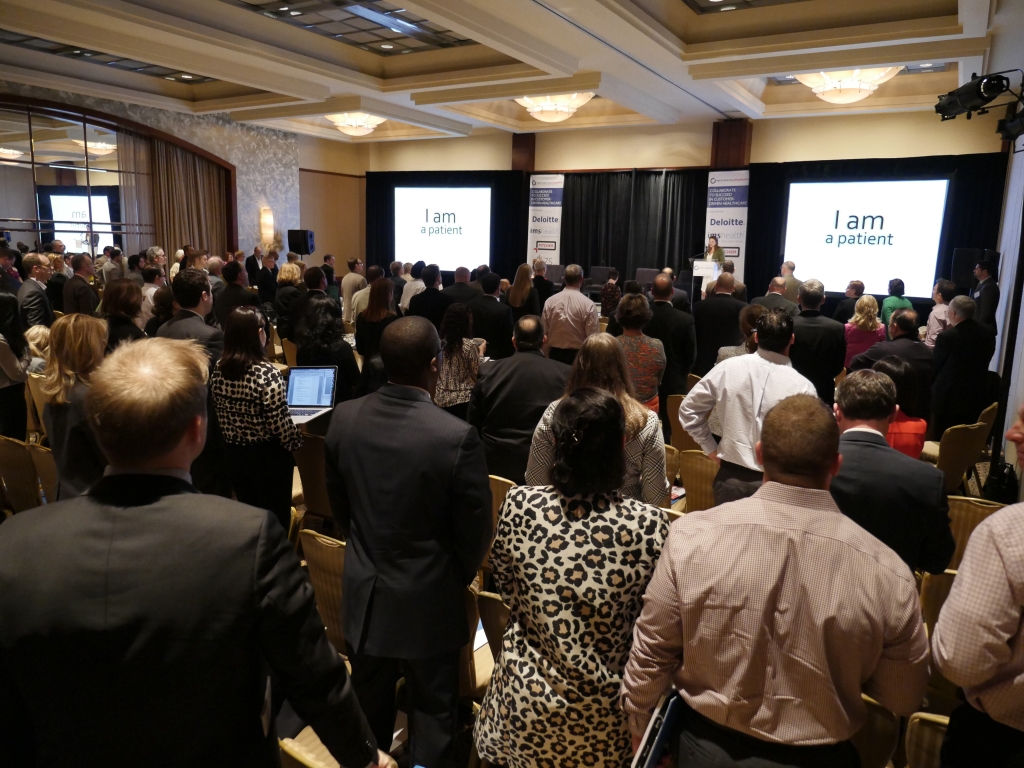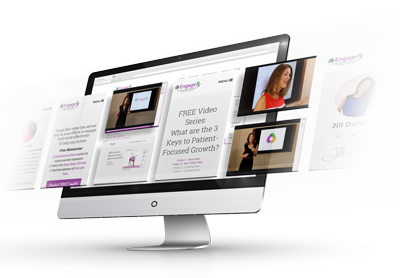From the podium I looked around the room at 400+ commercial pharma leaders from the US and wondered; will they be as advanced as their peers in Europe? I had just returned from the eyeforpharma conference in Barcelona where I was downright impressed by pharma’s progress. We had meaningfully shifted from a focus on the product to a focus on the patient.
In my opening comments as chair, I asked conference attendees: “Why are you here?” I suspected that for some it was to hear their peer’s approaches to problems we had in common, for others it was to network or to share their ideas with others. (All good reasons!) But there was a more important reason.
When pharma professionals get together and share ideas we can save and improve lives. Not just patients’ lives; family’s and caregivers’ too. At eyeforpharma Philadelphia, we moved the needle. We worked together to figure out how to serve differently and better.
Matt Portch, Team Leader in Commercial Effectiveness at Pfizer, kicked off the keynote session with his presentation: “From brand-centric to customer-centric: Stay relevant and be recognized as a partner in healthcare by reinventing your commercial model.” He set the tone for the conference. He inspired us to change by showing us why and how we must evolve our business model to become more patient centric. And that was just the beginning.
“No one got into pharma so they could make money from sick people,” said keynote presenter Anita Burrell, Former Head of Commercial Operations Effectiveness at Sanofi. And it is so true. She challenged us by asking “Should we really be patient centric?” I held my breath. “Oh no, where is she going?” I thought. But she continued saying, really we are all patients, so why separate “them” and “us” and instead let’s be “people centric”! Us and them? No. It is just us.
Bruce Lavin from UCB presented a new picture of our universe with the patient in the centre and encouraged us to start thinking of ourselves as a service-based industry instead of a manufacturing-based industry.
The talks that followed added layer upon layer of examples of how we in pharma are re-inventing ourselves in patient- or people-focused ways. What started as a trickle, at previous conferences; first with a small track to talk about patient centricity, now is a flood. Patient centricity appeared in all tracks at the conference (sales and marketing, value partnerships and, of course patient focus). And it was loud and clear in the keynotes!
“Patients are pharma’s raison d’être,” said Paul Simms, “and it’s clear to me that the patient-centered movement is here to stay.” And movement is indeed what it is. I had suggested in my opening comments that we were all there to do as Wayne Gretzky famously quipped and “Skate to where the puck is going not to where it has been.” The jury has rendered its verdict. Patient centricity is where the puck is going! Three themes emerged around patient centricity. It can contribute to profitability. It can increase our trustworthiness and it will increase collaboration not just within departments but also between organizations.
1) Patient-Centricity and Profitability: Incompatible or Inseparable?
The progress since the 2014 conference was palpable. Last year there was a sense that pharma’s patient-centric movement might just be a fad. Many wondered if it could really find a home in a business that needs to be profitable to survive.
Between conference sessions this year, Paul Simms and I addressed the status of the patient-centered movement through interviews with as many senior pharma leaders as we could. We asked each of them: “Are patient centricity and profitability incompatible or inseparable?” We thought this might still be an unclear, but in the minds of these senior leaders, it wasn’t. We thought they might falter but they didn’t! They confidently assured us that patient centricity and profitability are inseparable and even cited proof from their outcomes!
In both Barcelona and Philadelphia, attendees had set aside the question of whether to be patient centered and had moved to the question of how to be patient centered. Most had realized that when we put patients first, business will follow. And for those who hadn’t made that leap yet, they were going back home with an earful! “My company isn’t there yet,” said one participant, “but boy do I have a lot to share when I get back! We’ve got some catching up to do!”
2) Patient Centricity: Climbing our way back to trustworthiness
But just as I was feeling proud thinking of all of the people that would be served through collaboration and patient-focus, one of the presentations from eyeforpharma Barcelona was nagging me. The presentation I’m referring to was by Keith Allen of Novartis who showed us that trust in our industry is still decreasing! I think that we sometimes tacitly accept this as an intractable problem. We shouldn’t because it costs lives. Nowhere is this more obvious than the recent pandemic of people choosing not to vaccinate their children against infections that had all but been eliminated decades ago.
Although the reasons for this deeply concerning trend are complicated, at least part of the problem is a lack of trust. Our science is not trusted. Our people are not trusted. Our intentions are not trusted. Did we earn some of that mistrust? Yes. Can we learn from our mistakes and earn back our trust? Yes. We must.
Trust matters to individual companies as much as it matters to our industry broadly. It makes it easier for patients to get the benefits of our drugs and contributes to the sustainable cycle of making new medicines.
Having trust and being believed are quantifiable in the same way we quantify the societal value of medicines through pharmacoeconomic analyses. I think that the cost of re-creating trust is a lot lower than we may think while the expense of not re-creating it is tremendous. We’ve taken an excellent first step with the creation of patient programs and bringing patients to the front of the room and listening to them. It seems we are now ready for the next step; turning each person in our organization into a “soldier of the patient’s will” as Anne Beal, Chief Patient Officer at Sanofi encourages.
Eric Rothstein, Executive Director, Customer Channels and Solutions, from Merck flagged one of the key challenges for pharma pursuing this new approach. He noted: “We have to influence our people to change or get new people if we’re going to bring patient centricity to our culture”. Kim Stoddart from LEO talked about their extensive plan to change their culture including changing hiring practices. Who they are looking for is different now than before. They are looking for purpose-driven, passionate people who want to serve. Lita Sands, formerly Global Head of Digital Transformation at Novartis, underlined the idea that our patient-centered approach requires us to think differently about how we create value. She said: “Pharma needs to see the many dimensions of the patient holistically—their disease, their genome, their set of behaviours, their environment and, most perhaps most importantly, their relationships to family and friends. Technology will enable us to deliver our medicines in this larger context.”
It’s time to bring patient centricity to all our people. It’s time to empower our people with the power of their purpose. It’s time to shift our mindset from product focus to people focus. Once our mindset changes, everything else will change too.
3) Patient-Centricity: Our New Mindset that binds
In both the European and North American conferences the desire to learn how to serve patients better was a tie that bonded us in a common purpose. Eyeforpharma attracts passionate, curious pharma leaders who have a sincere desire to make a difference. I felt like a kid in a candy store. Every time I turned around there was another brilliant, purpose-driven person to learn from. There was a willingness to share ideas with the belief that a rising tide lifts all ships. Nowhere was this more evident than during the awards night.
The inaugural eyeforpharma Philadelphia Awards was a huge success. It was designed to fuel the flame of innovation and collaboration. By sharing our best ideas we can build and grow faster as an industry than any one company can alone. It was no surprise that while there were five categories, the common thread was patient centricity. Congratulations to all! Tremendous projects. Check them out here. I felt so proud to work in this industry. And even more proud that people were freely sharing and wanting to collaborate
Bottom line, my confidence has been renewed. With this group of great people, surely we can figure out the solutions to our problems. Thank you eyeforpharma for the intense legwork to help us pull our thoughts together and for giving us the venue to share those thoughts. Thank you to the generous speakers and sponsors. You have done good work!
Seeds have been planted. And those seeds from this conference will help us collaborate to gain back our trustworthiness as an industry so we can serve differently and better. After all, the work we do is noble. Together…..





























Leave A Comment